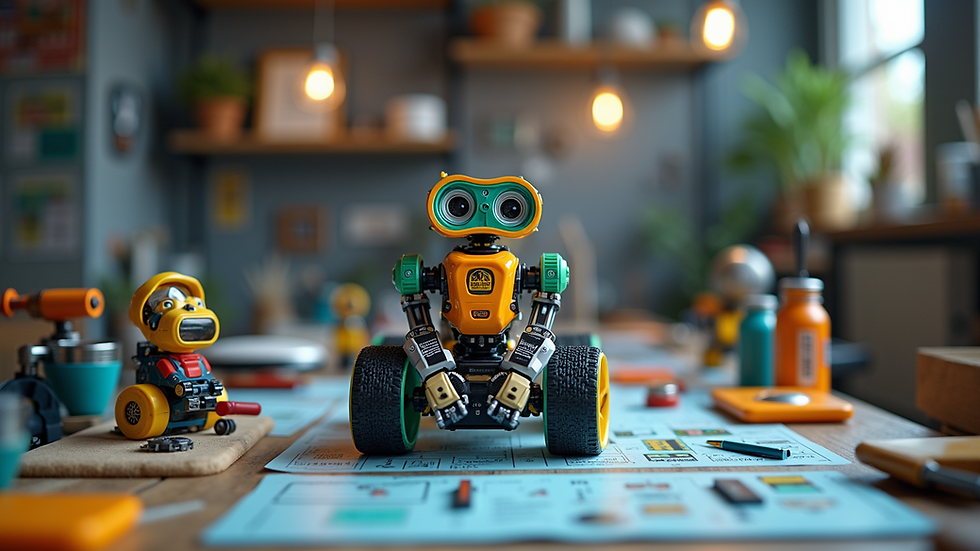Unlocking Creativity in Kids Through Robotics and Structured Learning
- Stef Marrero
- 7 days ago
- 4 min read
In today's fast-paced world, fostering creativity in children is more important than ever. As technology evolves, integrating robotics into education has emerged as a powerful tool to inspire young minds. Robotics not only fuels creativity but also aids children in processing their ideas and staying focused in school. This post explores how robotics can unlock creativity in kids and enhance their learning experiences.
The Intersection of Robotics and Creativity
Robotics merges engineering, programming, and design, offering children a unique way to express their creativity. When kids dive into robotics, they are not merely following instructions; they are inventing, experimenting, and solving problems. This hands-on approach encourages them to think critically and develop innovative solutions.
For example, a project where students design a robot that sorts objects by color allows them to explore concepts in coding and logic. When they build a robot that can navigate a maze or dance to music, they visualize their creative concepts and bring them to life. Such activities foster ownership and pride in their work, significantly boosting their confidence.
Enhancing Idea Processing Skills
One of the substantial benefits of robotics education is its ability to help children process ideas effectively. Designing and building a robot requires breaking down concepts into smaller, manageable steps. This structured approach enhances critical thinking, which is essential in today’s complex world.
A study showed that students engaged in robotics scored 25% higher in problem-solving assessments than those who did not participate. As children face robotics challenges, they learn to analyze problems, brainstorm solutions, and evaluate outcomes. This iterative process mirrors real-world scenarios where trial and error often drives success. Through robotics, kids cultivate a mindset that embraces challenges and views setbacks as growth opportunities.
Keeping Kids on Track in School
Robotics can also play a crucial role in keeping children focused and engaged in their studies. The interactive nature of robotics captivates students' attention and motivates them to participate actively. This engagement can be particularly beneficial for students struggling with traditional teaching methods.
Incorporating robotics into the curriculum makes learning enjoyable and relevant. For instance, teaching fractions through a robotics project, like programming a robot to evenly distribute items, can demonstrate practical applications of math in everyday life. This connection between theory and practice helps maintain interest and encourages students to stay on track academically.
Building Collaboration and Communication Skills
Robotics projects frequently require teamwork, helping children develop essential collaboration and communication skills. Working in groups to design and build a robot fosters a sense of community. This allows students to share ideas and perspectives, which enhances creativity while teaching the importance of listening to others' viewpoints.
For example, students who participate in group robotics competitions must delegate tasks, resolve conflicts, and celebrate each other's successes. According to educational studies, those who engage in group projects are 30% more likely to develop strong interpersonal skills compared to their peers in individual work settings. These skills are invaluable as they prepare students for future academic and professional environments where teamwork is essential.
Encouraging a Growth Mindset
Robotics education promotes a growth mindset, vital for fostering creativity and resilience in children. When faced with challenges while working on robotics projects, kids learn to persevere and adapt their strategies. This outlook encourages them to embrace challenges rather than avoid them.
For instance, a child who struggles with programming but continues to try different approaches will ultimately improve. By cultivating a growth mindset, children become more open to exploring new ideas and taking risks in their creative pursuits. They learn that creativity is not just about having great ideas but also about being willing to experiment and learn from mistakes. This perspective leads to greater innovation and a lifelong passion for learning.
The Role of Educators and Parents
To maximize the benefits of robotics in fostering creativity, educators and parents play a vital role. Teachers can integrate robotics into lesson plans, providing opportunities for hands-on projects that stimulate creativity. For example, a science teacher might have students build robots that measure environmental data, blending robotics with real-world challenges.
Parents can support this by encouraging their children to engage in extracurricular activities, such as robotics clubs or competitions. Creating a supportive environment at home and school is essential for nurturing creativity. Encouraging children to explore their interests, ask questions, and pursue ideas can lead to a more enriching educational experience.
Final Thoughts
Robotics is a powerful tool for unlocking creativity in kids and aiding their focus in school. By engaging with robotics, children develop critical thinking skills, enhance their collaboration abilities, and cultivate a growth mindset. As educators and parents, fostering an environment that encourages exploration and creativity is essential for preparing the next generation for a rapidly changing world.
Incorporating robotics into education makes learning more enjoyable and equips children with the skills they need to thrive in the future. By embracing this innovative approach, we can inspire young minds to dream big and turn their ideas into reality.



Comments